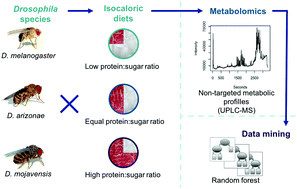当前位置:
X-MOL 学术
›
Integr. Biol.
›
论文详情
Our official English website, www.x-mol.net, welcomes your feedback! (Note: you will need to create a separate account there.)
Lipidomic profiles of Drosophila melanogaster and cactophilic fly species: models of human metabolic diseases
Integrative Biology ( IF 2.5 ) Pub Date : 2017-10-02 00:00:00 , DOI: 10.1039/c7ib00155j Daniel Cázarez-García 1, 2, 3, 4 , Mariana Ramírez Loustalot-Laclette 3, 4, 5 , Therese Ann Markow 3, 4, 5 , Robert Winkler 1, 2, 3, 4
Integrative Biology ( IF 2.5 ) Pub Date : 2017-10-02 00:00:00 , DOI: 10.1039/c7ib00155j Daniel Cázarez-García 1, 2, 3, 4 , Mariana Ramírez Loustalot-Laclette 3, 4, 5 , Therese Ann Markow 3, 4, 5 , Robert Winkler 1, 2, 3, 4
Affiliation

|
The metabolic syndrome (MetS) is associated with serious diseases and represents an important threat for global public health. The common fruit fly (Drosophila melanogaster) has served as a model organism to study physiological processes of the MetS, because central metabolic pathways are conserved among species, and because the flies are easy to cultivate in a laboratory. In nature, D. melanogaster is a fruit generalist, feeding on diets rich in simple carbohydrates. Other Drosophilids, however, have specialized on distinct resources. Drosophila mojavensis, for example, is endemic to the Sonoran Desert, where it feeds on necrotic cacti which are low in carbohydrates. Its close relative Drosophila arizonae is cactophilic as well, but is also found breeding in fruits containing simple sugars. Previous studies have shown that high-sugar diets negatively affect the larval development of D. mojavensis and increase their triglyceride content, compared to D. melanogaster. More general metabolic profiles, in response to these different diets, however, have yet to be produced for any of the species. In addition, because D. arizonae appears somewhat intermediate between D. melanogaster and D. mojavensis in its development times and survival under the above mentioned diets, its general metabolic profiles are also of interest. Thus, in the present study we ask to what extent the general metabolism of these three different Drosophila species is affected by diets of distinct protein–sugar ratios. To obtain an un-biased view on possibly novel phenomena, we combined untargeted metabolomics with Random Forest data mining.
中文翻译:

果蝇和拟蝇蝇类的脂质谱:人类代谢疾病的模型
代谢综合症(MetS)与严重疾病有关,对全球公共健康构成重要威胁。常见的果蝇(果蝇Drosophila melanogaster)已成为研究MetS生理过程的模型生物,因为物种之间的中央代谢途径是保守的,而且果蝇易于在实验室中培养。在自然界中,黑腹果蝇是一种水果通才,以富含简单碳水化合物的饮食为食。但是,其他果蝇类则专门研究独特的资源。例如,果蝇是索诺兰沙漠的特有种,它以碳水化合物含量低的坏死仙人掌为食。其近亲果蝇也是嗜酸的,但也发现在含单糖的水果中繁殖。先前的研究表明,与黑腹果蝇相比,高糖饮食对莫氏果蝇幼虫的发育产生不利影响,并增加其甘油三酸酯含量。然而,尚未针对任何物种产生响应于这些不同饮食的更一般的代谢概况。另外,由于亚利桑那D. arizonae出现在D. melanogaster和D. mojavensis之间的中间位置就其在上述饮食下的发育时间和存活率而言,其一般的代谢特征也很重要。因此,在本研究中,我们要问这三种不同的果蝇物种的总体代谢在多大程度上受到蛋白质-糖比不同的饮食的影响。为了获得对可能新颖现象的无偏见,我们将无目标代谢组学与随机森林数据挖掘相结合。
更新日期:2017-10-18
中文翻译:

果蝇和拟蝇蝇类的脂质谱:人类代谢疾病的模型
代谢综合症(MetS)与严重疾病有关,对全球公共健康构成重要威胁。常见的果蝇(果蝇Drosophila melanogaster)已成为研究MetS生理过程的模型生物,因为物种之间的中央代谢途径是保守的,而且果蝇易于在实验室中培养。在自然界中,黑腹果蝇是一种水果通才,以富含简单碳水化合物的饮食为食。但是,其他果蝇类则专门研究独特的资源。例如,果蝇是索诺兰沙漠的特有种,它以碳水化合物含量低的坏死仙人掌为食。其近亲果蝇也是嗜酸的,但也发现在含单糖的水果中繁殖。先前的研究表明,与黑腹果蝇相比,高糖饮食对莫氏果蝇幼虫的发育产生不利影响,并增加其甘油三酸酯含量。然而,尚未针对任何物种产生响应于这些不同饮食的更一般的代谢概况。另外,由于亚利桑那D. arizonae出现在D. melanogaster和D. mojavensis之间的中间位置就其在上述饮食下的发育时间和存活率而言,其一般的代谢特征也很重要。因此,在本研究中,我们要问这三种不同的果蝇物种的总体代谢在多大程度上受到蛋白质-糖比不同的饮食的影响。为了获得对可能新颖现象的无偏见,我们将无目标代谢组学与随机森林数据挖掘相结合。



























 京公网安备 11010802027423号
京公网安备 11010802027423号